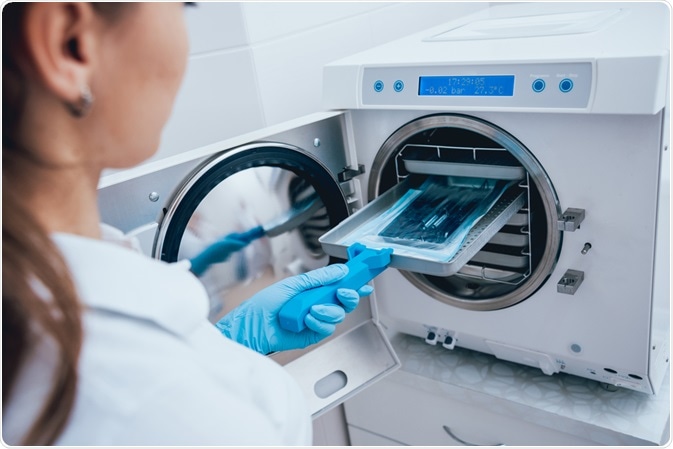An autoclave is a piece of equipment used to sterilize objects using high-pressure steam. Many fields and industries utilize autoclaves, including medicine, tattoo parlors, dentistry, and most areas of research that are concerned with sterile conditions.
 Romaset | Shutterstock
Romaset | Shutterstock
How do autoclaves sterilize materials?
Firstly, air is removed from the autoclave chamber in order to create a very low-pressure environment. Moist heat, in the form of steam, in this case, is far more reliable than dry heat in destroying microorganisms and spores as it transfers heat more effectively, thus all trapped air is removed to ensure that the steam is not diluted by air.
It should be noted that lower temperatures of moist heat are able to destroy contaminants as effectively as much higher temperatures of dry heat, allowing more fragile materials such as clothing to be sterilized. The air may be removed by vacuum pumps or other methods such as downward displacement.
Steam is then pumped into the autoclave chamber to a pressure of approximately 100 kPa, usually at around 121⁰C for fifteen minutes, though this may be adjusted depending on requirements. Sterilization cycles of 134⁰C for just three minutes are also common.
The water source used to generate the steam is usually purified beforehand, and monitoring systems are in place in larger installations to ensure that the steam does not introduce additional contaminants.
The dryness or wetness of steam refers to the amount or number of liquid water droplets contained within it. Steam that is 100% dry will contain no water droplets, while wet steam contains many. Additionally, dry steam has a larger volume, as some of its components are in the denser liquid form, and also higher enthalpy and entropy, meaning that it is hotter while possessing the same energy.
However, 100% dry steam is less efficient at transferring heat, and so sterilizing an object. Therefore, steam of around 3% wetness is frequently used in autoclaves to create an optimum between the high temperature and pressure of dry steam, and the heat transfer ability of wet steam.
Following the application of steam, a short drying procedure takes place The length of drying time depends on various factors including the wetness of the steam.
Modern autoclaves are suitable for sterilizing almost any object that is able to survive the high temperatures and pressures of the cleaning process. This means that some types of plastics cannot be sterilized using an autoclave. They are available in a variety of sizes, from small tabletop instruments to large chambers of several meters in each dimension.
Understanding Steam Sterilization
History of the autoclave
In the late 1800s, Louis Pasteur published his findings regarding microbes, and in 1879 the first autoclave was built by Charles Chamberland, his student. Prior to this time open flaming or chemical washing were the primary methods used to sterilize equipment for surgery and microbiology research, though a more efficient method was desired. Following the invention of the autoclave, it was quickly adopted by hospitals, universities, and sterile manufacturing facilities.
Alternative applications of autoclaves
Autoclaves are sometimes used for applications outside of sterilization, such as the curing and vulcanization of large rubber objects. Radiator hoses meant for use in vehicles are one example of such a product. Quartz crystals are also hydrothermally grown inside autoclaves, as the high temperature and pressure replicate the conditions under which they would naturally form.
Sources